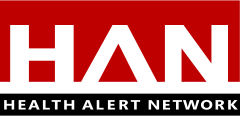Monitoring for Increased Levels of Radioactive Material in the US as a Result of the Incident with the Fukushima Nuclear Incident in Japan
Distributed via the CDC Health Alert Network
Sunday, March 27, 2011, 12:20 EDT (12:20 AM EDT)
CDCHAN-00320-2011-03-27-ADV-N
Summary
As a result of the incident with the Fukushima nuclear plant in Japan, highly sensitive radiation monitors operated by EPA and others are detecting very low levels of radioactive material in the air in the United States. These levels were expected and consistent with estimated releases from the damaged nuclear reactors and are far below levels of public health concern.
Elevated levels of radioactive material in rainwater have also been expected as a result of the nuclear incident after the events in Japan, since radiation is known to travel in the atmosphere. There have been reports received that several states including Pennsylvania and Massachusetts have detected elevated levels of radiation in rainwater following recent precipitation events.
Background
The numbers of the elevated levels of radioactive material being reported in Massachusetts are 79 picocuries (pCi) per liter (one picocurie is a trillionth of a curie). The numbers reported in Pennsylvania range from 40-100 picocuries per liter. Although these are levels above the background levels historically reported in these areas, they are still about 25 times below the level that would be of concern for use as a sole source of water over a short period of time, even for infants and pregnant or breastfeeding women, who are the most sensitive to radiation.
While short-term elevations such as these do not raise public health concerns – and the levels seen in rainwater are expected to be relatively short in duration – the U.S. EPA has taken steps to increase the level of monitoring of precipitation, drinking water, and other potential exposure routes to continue to verify that.
Given the release of radiation in Japan, it was expected that radiation monitors in this country and elsewhere will detect minute quantities of radiation. These monitors are highly sensitive and can detect amounts of radiation in trillionths of a Curie. We expect environmental monitors will continue to detect low levels of radiation in surface waters due to radioactive material in the air. When it rains or snows, the radioactive material is washed to the ground and onto surface waters.
What the US Federal Government is Doing
EPA’s Radiation air monitoring network continues to conduct near-real-time air monitoring in networks across the nation. With these recent reports, the US EPA has increased monitoring across the country to ensure that the American people have the most up to date information.
What information is available to the public:
The EPA has posted information on its website at http://www.epa.gov/japan2011/
CDC has posted FAQs on our website at http://emergency.cdc.gov/radiation/isotopes/iodine131surfacewater.asp.
USA.gov continues to consolidate federal guidance related to this situation at http://www.usa.gov/Japan2011.shtml.
Recommendations
The federal government’s only recommendation to state and local governments at this time is to continue to share their testing results with the appropriate federal authorities. EPA will continue to communicate nationwide sampling results as they come in.
At this time, there continues to be no indication for anyone in the United States to take potassium iodide or switch to bottled water on the basis of the events in Japan.
The Centers for Disease Control and Prevention (CDC) protects people’s health and safety by preventing and controlling diseases and injuries; enhances health decisions by providing credible information on critical health issues; and promotes healthy living through strong partnerships with local, national and international organizations.
Department of Health and Human Services
HAN Message Types
- Health Alert: Conveys the highest level of importance about a public health incident.
- Health Advisory: Provides important information about a public health incident.
- Health Update: Provides updated information about a public health incident.
###
This message was distributed to state and local health officers, state and local epidemiologists, state and local laboratory directors, public information officers, HAN coordinators, and clinician organizations.
###

